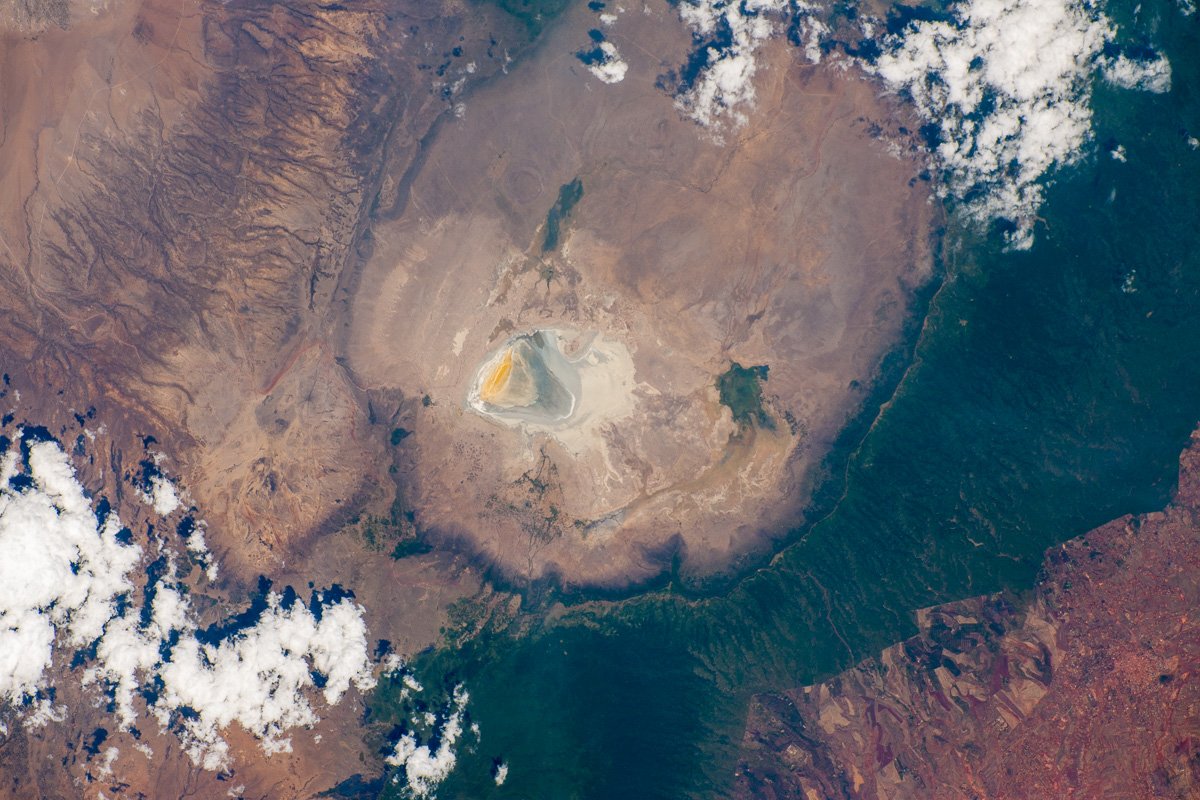[:ja]セルゲイ・リャザンスキー宇宙飛行士がISSから撮影したタンザニアのンゴロンゴロ自然保護区です。

タンザニアの北部にあるンゴロンゴロ保全地域は、ンゴロンゴロ・オルモティ・エンパカーイという3つのクレーターが並び、これら活動を停止したものも含め9つの火山が分布します。ンゴロンゴロクレーターは300万年前に出来た火山のカルデラに広がる盆地で、外輪は南北16km、東西19kmと世界有数のカルデラで、中央には湖が存在します。人類発祥の地と目されるオルドパイ渓谷がこのクレーターの西にあります。ンゴロンゴロの外輪は標高2,400mあり、カルデラ内部の平野(1,800m程度)と比べて高く、カルデラ内部は外部と遮断されており、このカルデラ内に生息する大型動物のほとんどはカルデラの外に出ることはありません。周囲と隔離された生態系が形成されるに至りましたが、キリンやインパラ以外の東アフリカのサバンナに生息する動物はほぼ観察することができます。
地上の様子はこちらです。

参考文献: Sergey Ryazansky’s Tweet
地球俯瞰画像を見る: LiVEARTH
[Earthview Wonders] No.799: Ngorongoro Conservation Area🇹🇿
Astronaut Sergey Ryazansky captured from ISS Ngorongoro Conservation Area, Tanzania.

The Ngorongoro Conservation Area is a protected area and a World Heritage Site located in the Crater Highlands area of Tanzania. The area is named after Ngorongoro Crater, a large volcanic caldera within the area. The crater, which formed when a large volcano exploded and collapsed on itself two to three million years ago, is 610m deep and its floor covers 260km2. Although thought of as “a natural enclosure” for a very wide variety of wildlife, 20% or more of the wildebeest and half the zebra populations vacate the crater in the wet season, while Cape buffalo stay; their highest numbers are during the rainy season. A side effect of the crater being a natural enclosure is that the lion population is significantly inbred. This is due to the very small amount of new bloodlines that enter the local gene pool, as very few migrating male lions enter the crater from the outside. Those who do enter the crater are often prevented from contributing to the gene pool by the crater’s male lions, who expel any outside competitors.
The local scenery on the ground is as follows.

Reference: Sergey Ryazansky’s Tweet
See earthview photo gallery: LiVEARTH[:en][Earthview Wonders] No.799: Ngorongoro Conservation Area🇹🇿
Astronaut Sergey Ryazansky captured from ISS Ngorongoro Conservation Area, Tanzania.

The Ngorongoro Conservation Area is a protected area and a World Heritage Site located in the Crater Highlands area of Tanzania. The area is named after Ngorongoro Crater, a large volcanic caldera within the area. The crater, which formed when a large volcano exploded and collapsed on itself two to three million years ago, is 610m deep and its floor covers 260km2. Although thought of as “a natural enclosure” for a very wide variety of wildlife, 20% or more of the wildebeest and half the zebra populations vacate the crater in the wet season, while Cape buffalo stay; their highest numbers are during the rainy season. A side effect of the crater being a natural enclosure is that the lion population is significantly inbred. This is due to the very small amount of new bloodlines that enter the local gene pool, as very few migrating male lions enter the crater from the outside. Those who do enter the crater are often prevented from contributing to the gene pool by the crater’s male lions, who expel any outside competitors.
The local scenery on the ground is as follows.

Reference: Sergey Ryazansky’s Tweet
See earthview photo gallery: LiVEARTH[:]